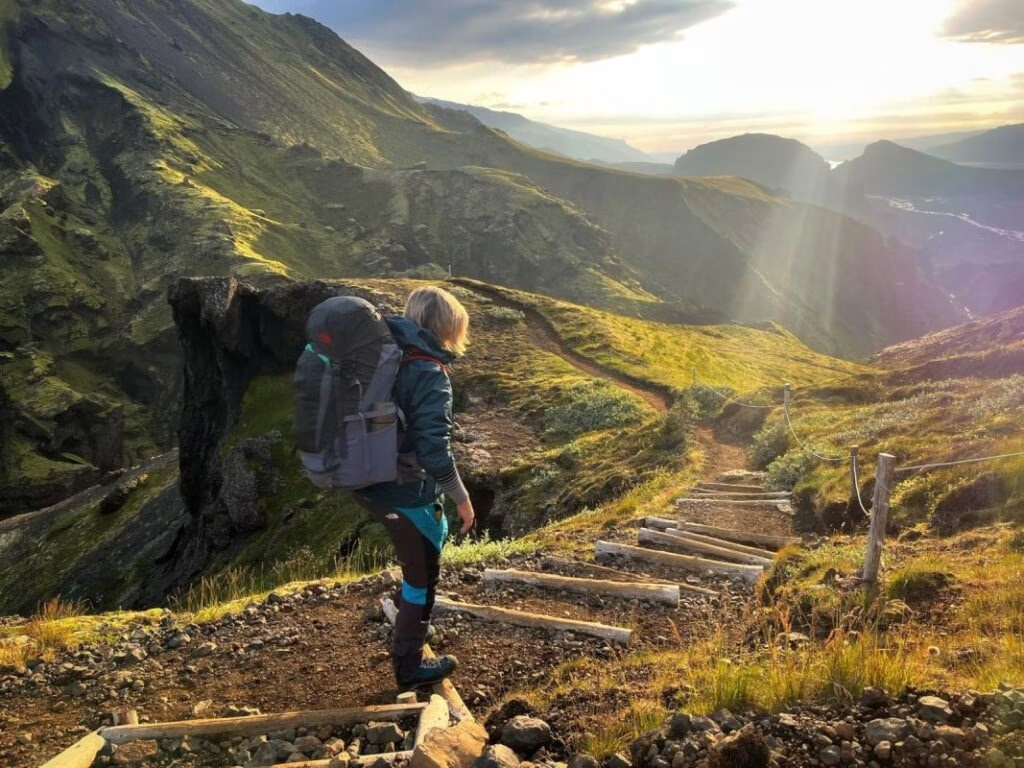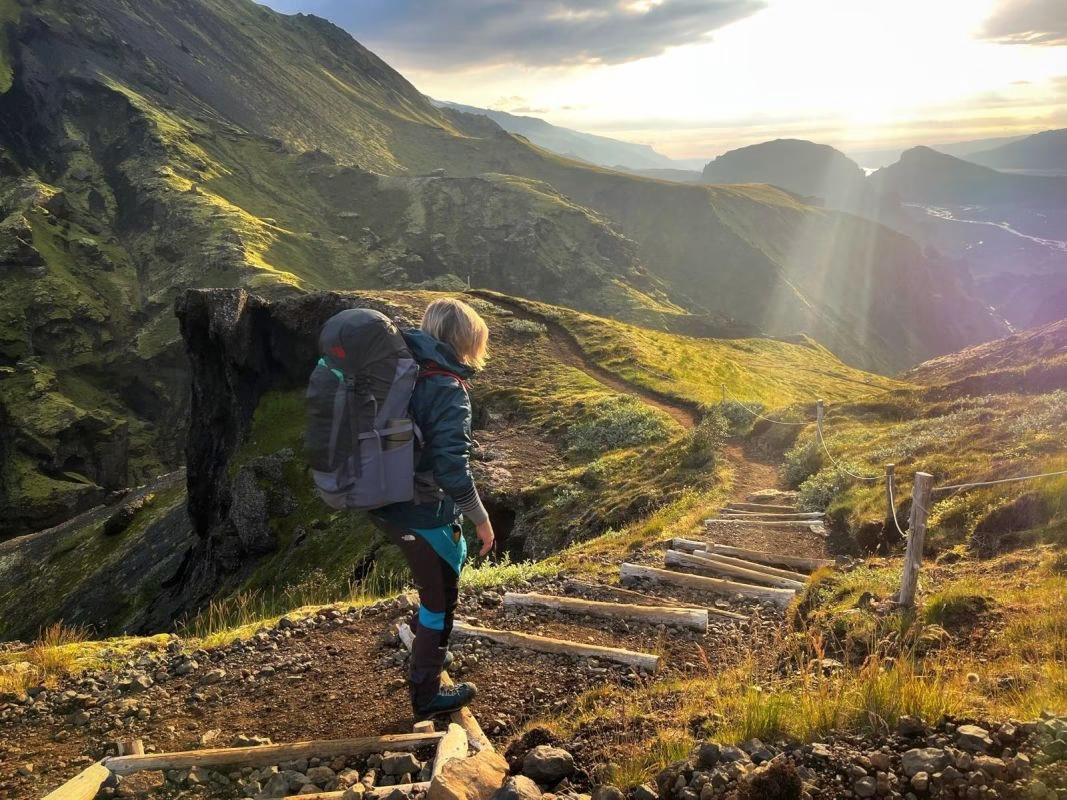There is a unique beauty in nature that reveals itself when the heavens pour down, transforming landscapes and awakening our senses in ways that cannot be experienced during sunny days.
However, rainy conditions may turn the best hiking adventure into a real nightmare! So it’s highly important to be predictable and prepared for sever weather conditions. It’s a common practice to check weather forecast before going for a hike – especially in highlands. But be aware the weather may alwayds change rapidly.
Hiking in the rain may seem unconventional, but those who dare to venture out and embrace this experience are often rewarded with a renewed sense of awe and wonder for the world around them.
GOOD ATTITUDE WINS OVER ANY STORM.
Rainy hikes don’t just offer an opportunity to witness nature’s power; they also provide a chance to develop resilience and adaptability. When faced with damp conditions and muddy trails, hikers learn to appreciate the importance of proper gear, planning, and preparedness.
Moreover, hiking in the rain can make familiar trails feel entirely different, enhancing your senses and allowing you to experience your surroundings from an entirely new perspective.
Here you’ll find essential tips for staying safe and comfortable while hiking in the rain. Grab your waterproof gear and read on to learn how to turn a rainy day into a successful and safe adventure!
Key Takeaways
- Hiking in the rain offers unique experiences and encourages adaptability and resilience.
- Essential gear includes waterproof clothing, boots, a backpack, and a quick-dry towel.
- Avoid cotton if possible!
- Trekking poles enhance stability on wet, muddy terrains.
- While hiking, be weather-aware, check forecasts, and monitor for incoming storms.
- Safety measures for hiking in the rain include planning ahead, sticking to designated trails, and maintaining communication.
- For rainy hikes, pack nutritious foods like energy bars, trail mix, and warm beverages.
- If possible, travel in a group.
- Always carry a well-stocked first aid kit.
Preparing for your hike: Essential hiking gear and attire
The foundation of a successful rainy day hike lies in the proper gear and attire. This is essential for ensuring your safety and comfort throughout the adventure. Here are the must-haves:
- Waterproof jacket. A good waterproof jacket is a vital piece of clothing for a rainy hike. It should be breathable to prevent you from overheating during physical activity. Look for hiking rain jackets with a durable water-repellent (DWR) finish.
- A tiny, light poncho you can wear over your clothes and backpack in heavy rain. Available in many shops for less than 10 euros.
- Waterproof hiking pants. Like the rain jacket, your pants should be waterproof or at least water-resistant. Full side zippers can be helpful for putting them on without needing to remove your boots.
- Waterproof hiking shoes. These will keep your feet dry even if you step in puddles or go on a muddy trail. For heavy rain, hiking boots will be a great choice, because they cover not only the feet but also the ankles. They should also be breathable and have a sturdy, grippy sole for slippery surfaces.
- Moisture-wicking and quick-drying clothing. Choose synthetic or wool fabrics that wick moisture away from your body and dry quickly. Nylon and polyester are also good choices for wet weather. Avoid cotton and linen.
- Waterproof backpack or rain pack cover. A waterproof backpack or pack cover is crucial for protecting your supplies from getting wet.
- Rain cover for your head. This could be a waterproof hat, or simply the hood of your rain jacket.
- Waterproof gaiters. Gaiters can be a handy addition to your rain gear. They are great for preventing water from getting into your boots and help protect your lower legs from scratches and dirt.
- Quick-dry towel. A small towel made of polyester, nylon, or polyamide can be helpful for drying off your gear or keeping your face and body relatively dry.
- Waterproof gloves or mittens. Cold, wet hands can lead to joint issues in the future, so it’s wise to protect them with waterproof gloves or mittens.
- Trekking poles. Equip yourself with sturdy trekking poles for extra stability and support.
- Tent and a sleeping bag. If you plan to stay on the trail overnight, you’ll need more protection than your rain jacket, waterproof pants, and waterproof hiking boots. Aside from a tent, look for sleeping bags filled with synthetic insulation. Also, consider a bag with a higher temperature rating to combat potentially cold, wet conditions. A mummy-style sleeping bag can provide extra warmth.
- My personal preference for additional gear is: thermos with hot lemon, ginger and honey tea, whistle (in case of strong winds nobody would hear your voice, but whistle yes), mirror (for sunray reflection).
Navigating wet and muddy terrain.
Slippery trails can make hiking more challenging (welcome to Ireland!!), but with the right techniques, you can confidently tackle wet and muddy terrain. These are the tips you can follow when hiking in the rain:
- Assess the situation. Before stepping onto a muddy or slippery section, take a moment to evaluate the area and identify the safest path.
- Utilize trekking poles. As mentioned earlier, trekking poles can significantly enhance stability. Plant your poles firmly into the ground before taking each step to increase balance and control.
- Maintain a steady pace. Avoid sudden movements or rapid changes in direction, as these can cause you to lose your footing. Instead, move at a steady, controlled pace, focusing on each step as you go.
- Watch your footing. Be mindful of where you place your feet, particularly when traversing steep or uneven terrain. Keep an eye out for loose rocks or hidden obstacles that could cause you to slip or trip. Make sure you wear waterproof hiking shoes.
- Adapt your stride. Shorten your stride on slippery surfaces to maintain better control and balance. Take smaller steps and avoid overextending your legs, which could lead to slipping.
- Practice good trail etiquette. When encountering other hikers on narrow or slippery trails, communicate your intentions and yield when necessary to ensure everyone’s safety.
- Learn from experience. As with any outdoor activity, practice makes perfect. The more time you spend hiking in wet conditions, the better equipped you’ll be to handle bad weather confidently and safely.
Staying Safe during Thunderstorms: Weather Awareness.
Safety should always be the top priority while hiking in the rain. Before setting out, check the local weather forecast and remain vigilant for signs of incoming storms, such as dark clouds or sudden wind shifts.
In addition to monitoring the weather, consider the following strategies to minimize the potential hazards of hiking in the rain.
- Plan ahead. Familiarize yourself with the trail, its potential challenges, and bailout points. Ensure that you have adequate rain gear, food, water, and navigation equipment. Inform someone of your planned route and expected return time.
- Stay on designated trails. Avoid straying from established paths, as this can increase the risk of getting lost or encountering dangerous terrain, especially in wet weather. Stick to well-marked trails, particularly in low visibility conditions.
- Maintain communication. Carry a fully charged mobile phone. You can also pack a lightweight power bank. Remember that reception may be limited in remote areas, so consider investing in a satellite communicator or personal locator beacon (PLB).
- Travel in a group. If possible, hike with at least one other person to provide support and assistance in case of injury or other emergencies.
- Be careful around river crossings. Heavy rainfall can cause rivers and streams to rise quickly, making crossings more dangerous. Assess each crossing cautiously and determine whether it’s safe to proceed. If in doubt, turn back or find an alternative route.
- Know your limits. Be realistic about your fitness level and experience when planning a rainy hike. It’s better to choose a shorter or less challenging route than to risk injury or exhaustion on a trail that’s beyond your capabilities.
- Carry a first aid kit. Accidents can happen at any time, but slippery conditions and bad weather increase the likelihood of falls or injuries. That’s why, aside from rain gear such as rain jackets and rain pants, you should invest in a well-stocked first aid kit and familiarize yourself with basic first aid procedures.
Nutritious and comforting snacks for hikes on rainy days
When hiking in wet conditions, it’s essential to pack easy snacks to fuel your body with something nutritious and comforting that provides energy, warmth, and satisfaction. Good food will also help you keep a positive attitude and, as a result, you’ll enjoy hiking in the rain more.
Here are some suggestions for tasty and nourishing snacks that can be enjoyed during rainy hikes:
- Energy bars. Opt for high-quality, protein-packed energy bars made with natural ingredients like nuts, seeds, and dried fruits. These portable and non-perishable snacks provide a quick energy boost without taking up much space in your backpack. You can also keep them in the rain jacket and rain pants pockets for easy access. I know people say energy bars are not that healthy, as they are packed with sugar. But you need SUGAR in cold, windy and mountain conditions. Your body temperature can drop easily and with energy reduction you may start feeling really week. I’m saying this from my own experience, even on easy trails I was cought with a bad weather and it wasn’t fun.
- Dar chocolate – irreplaceable!
- Trail mix. Create your own custom blend of trail mix using a variety of nuts, seeds, dried fruits, and dark chocolate chips for an energy-dense snack that is both delicious and satisfying.
- Jerky plant-based alternatives, jerky provides a high-protein snack that is perfect for wet conditions due to its low moisture content and long shelf life.
- Nut butter packets. Single-serving nut butter packets (such as almond or peanut butter) are a convenient and mess-free option for adding healthy fats and protein to your snack repertoire.
- Instant oatmeal or couscous. Prepare individual servings of instant oatmeal or couscous in Ziploc bags before your hike. When you’re ready for a warm, comforting snack, simply add hot water from a thermos or portable camp stove.
- Hard cheese and whole-grain crackers. Hard cheese varieties like cheddar or gouda hold up well in wet conditions and pair nicely with whole-grain crackers for a tasty and satisfying snack.
- Dehydrated soups. Packets of dehydrated soup can be easily rehydrated with hot water from a thermos, providing a warm and nourishing pick-me-up during damp multi-day hikes.
- Hot beverages. Fill a thermos with hot tea, coffee, or cocoa to enjoy a warming drink alongside your snacks, helping to raise your body temperature and provide a comforting break on the trail.
- Fresh fruit (bananas are the best). While some fruits may not hold up well in wet conditions, sturdy options like apples or oranges can provide a refreshing and nutritious snack that’s packed with natural sugars for an energy boost.
- Homemade energy balls. Make your own energy balls using ingredients like dates, nuts, seeds, and cocoa powder for a wholesome and satisfying snack that is easy to transport and enjoy on the trail.
- Remember not to leave any trash behind you, put it in the bag and bring back down. Food remainings may also attract wild animals, which you don’t want to meet on your hiking way. It’s very common in Polish mountains – Tatra, when hikers are attacked by mountain bears as they track food brough by the tourists.
Remember to pack your snacks in waterproof containers or zip-top bags to keep them dry during your hike. You can even use a trash bag for an extra layer of protection in rainy weather.
First Aid Essentials for hiking in the rain.
When hiking in the rain, it’s essential to have a well-stocked first aid kit aside from all the clothes and gear that you’re going to wear hiking.
- Waterproof case or bag. Choose a waterproof case or dry bag to store your first aid supplies, ensuring they remain dry and functional when you need them.
- Adhesive bandages and gauze. Pack an assortment of waterproof adhesive bandages in various sizes, as well as gauze pads and rolls for covering and securing wounds in damp conditions.
- Antiseptic wipes and ointment. Include antiseptic wipes for cleaning minor cuts, scrapes, and insect bites, along with an antibiotic ointment to help prevent infections in wet conditions.
- Blister treatment. Rain and moisture can exacerbate blisters, so pack blister cushions or moleskin patches to protect and treat any hotspots that develop during your hike.
- Elastic bandages or cohesive tape. Support injured joints or muscles by including elastic bandages (such as ACE wraps) or self-adherent cohesive tape in your kit.
- Tweezers and a tick removal tool. When it rains, ticks can become more active. Pack a pair of tweezers and a tick removal tool to safely remove any unwanted hitchhikers.
- Emergency blanket. A compact space blanket can be a lifesaver if you need to retain body heat during an unexpected stop or emergency in wet and cold conditions.
- Pain relievers. Include over-the-counter medications like ibuprofen or acetaminophen to alleviate pain, reduce inflammation, or lower a fever if necessary.
- Personal medications and supplies. Remember to pack any personal medications you may need, as well as items like an inhalator or EpiPen if you have severe asthma or allergies.
- Safety whistle and a signaling mirror. In case you need to signal for help during your adventure, include a safety whistle and signaling mirror in your first aid kit. You can also carry these items in the pockets of your rain pants so that you can grab them without a hassle.
The victory belongs to the most tenacious! 😉
Hiking in the rain, while challenging, presents a unique opportunity to connect with nature in a fresh and invigorating way.
Thanks to equipping yourself with waterproof gear and prioritizing safety, you can transform a rainy day into an exciting adventure. Remember to also prepare some delicious and comforting snacks and carry a well-stocked first aid kit. Up there they taste hundred times better ;)))
The experience instills a sense of resilience, adaptability, and a new-found appreciation for the environment. Above all, it allows us to find joy and serenity amid the downpour, and witness the earth’s raw beauty in its most authentic form.

Note: This post may contain affiliate links, which are at absolutely no cost to you – I can earn a small commission on sales generated through this website and thanks to that I can share travel guides and inspirations that may help you reach your dream destinations and discover our unique world. I only recommend sites I actually use and have traveled to. Thank you for your support!





